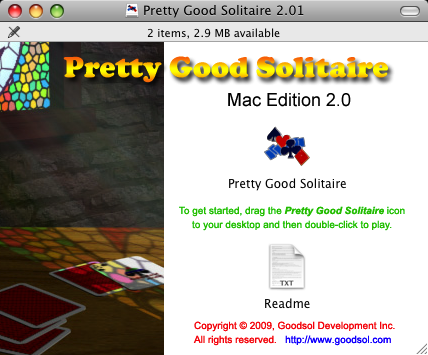There are some issues under Snow Leopard.
In a blog post last year, I gave detailed instructions on Making Mac Disk Images Pretty. Unfortunately, I have discovered that the most recent version of Mac OS X has some issues of which developers should be aware when using that technique (not that there is any obvious alternative).
I recently upgraded my development system to Mac OS X 10.6 (Snow Leopard). Apple is fairly aggressive with requirements for its development tools, and I need to upgrade in order to use the latest iPhone SDK. Of course, I already had a Snow Leopard partition that I had used for testing, so I knew that our software would work, and I never experienced any previous problems.
When the time came to build an update for one of our products (FreeCell Plus 4.00/4.01), I had a few minor niggles with Xcode 3.2.1 (the latest version), described later, but I got the product built and packaged properly. Then it was time for testing on our other supported versions of Mac OS X, Tiger (10.4) and Leopard (10.5), and I was surprised to learn that, although the software itself ran flawlessly, the disk images showed no background image when mounted, and the folder size was wrong. The icons were in the correct locations, relative to the top left corner of the window, so the formatting was not entirely ignored, just effectively ignored.
After some research into the problem, I found the answer in this DropDMG forum thread, where it is stated that Apple has confirmed this as a bug in Snow Leopard. I moved DropDMG over to my Leopard partition, rebooted to that version of Mac OS X (10.5), and build my packages there. That solved the problem, and the background images showed in all supported versions of OS X.
Conclusion: In order to have background images appear in disk images on older versions of Mac OS X, you must build the disk image under Leopard or earlier, not Snow Leopard.
Caveats: Sometimes, when opening a prepared disk image under Snow Leopard, there is a blank space on the bottom (probably not coincidentally exactly the same size as the folder toolbar), which does not appear on other versions of Mac OS X. Also under 10.6, the folder toolbar includes a slider control for quickly changing icon sizes (a.k.a., fouling up your layout). I have not been able to determine the cause of the former issue (yet) nor the reason for the latter. (How often does one actually change icon sizes that this is even remotely necessary?)
There were some build issues with Xcode 3.2.1 under Snow Leopard.
As I mentioned, I experienced a couple minor build issues after the upgrade to Xcode 3.2.1, both of which were addressed, albeit with differing degrees of success.
First, the default compiler in the latest version of Xcode is GNU 4.2, which is incompatible with the 10.4 (universal) SDK, and the very first build let me know that. Faced with a choice, downgrading the compiler to GNU 4.0 versus upgrading to the 10.6 SDK, I chose the latter, which I saw as the path of least resistance (see “Apple is fairly aggressive with requirements for its development tools” above). Unfortunately, at least for our project, the 10.6 SDK does not function as advertised and, despite properly setting the target OS to 10.4 (and obviously not using any 10.5 or 10.6 features), a product built with the 10.6 SDK will not run under Tiger (period), although it does work under Leopard. I switched (back) to GNU 4.0 and the 10.4 SDK and all was well.
Second, the latest version of Xcode upgrades its tools (obviously), and one seemingly innocuous change to the linker was to eliminate the need for the “-mlong-branch” compile option for certain object files (generally kernel files, which means primarily for Apple and not so much for the rest of us). Unfortunately, a warning message was added to that effect, yet Apple did not update its PPC object files accordingly. As a result, every time one links a universal binary (supporting PPC), the linker throws this warning: “Object file compiled with -mlong-branch which is no longer needed.” The only permanent solution is to recompile certain (protected) development files oneself, or wait until Apple fixes the problem.
The latter issue is extremely annoying to me, because now I am in the position of either ignoring linker warnings, which I never advise, or spending hours (or days) figuring out how to rebuild a portion of the development tools. Can you say, “not my job“? Personally, from my experience of Apple over the last few years, my bet is that this problem will soon be addressed by a campaign to suggest that developers should not continue to be stuck in the past supporting PPC systems.
Does anybody want a piece of that action?

